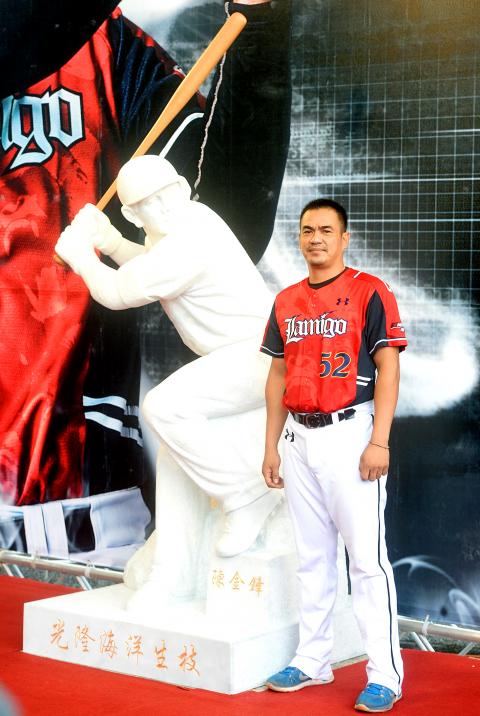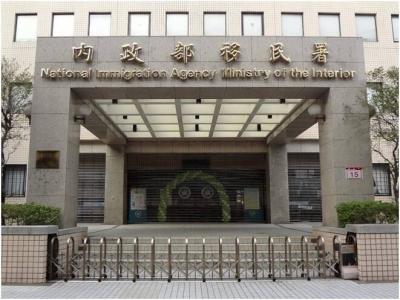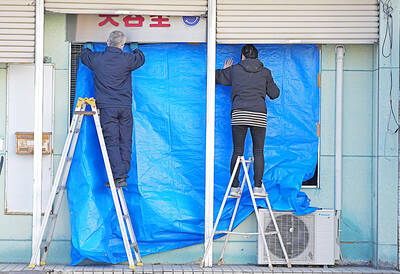A statue dedicated to baseball star Chen Chin-feng (陳金鋒) has drawn wide criticism for bearing little resemblance to the Lamigo Monkeys player, with public outrage escalating when it was discovered that the statue was made in China.
The white marble statue, which was donated by Kung-Long Ocean Biotech, has drawn so much condemnation that a crowdfunding venture was formally launched yesterday to make a more “stylish” bronze statue with a “more realistic portrayal” of Chen, headed by crowdfunding company Backer-Founder chief executive Tahan Lin (林大涵).
The marble statue was unveiled during a pre-game ceremony on Sunday at the Taoyuan International Stadium, with the day’s contest and other activities organized to pay tribute to Chen, the most prolific slugger in local baseball.

Photo: Ling Cheng-kung, Taipei Times
Chen is to retire at the end of this year after 11 winning seasons with the Lamigo Monkeys.
He was the first Taiwanese player to break into the US major leagues, when he debuted for the Los Angeles Dodgers on Sept. 14, 2002.
Right after the unveiling, many in the crowd expressed dismay and annoyance, saying the statue bore little resemblance to their baseball hero. Others were angry to see that the name of the donating company was larger than Chen’s name.
Expectation had been building since Lamigo club officials said the sculpture would cost more than NT$15 million (US$478,209) and two master rock sculptors with more than 30 years of experience had been commissioned for the job.
The statue, how it was made and photographs of Chen standing next to it quickly became a hot topic of discussion among sports fans and netizens on the Professional Technology Temple (PTT) — the nation’s largest academic online bulletin board — and other online chat sites.
Most netizens wrote that it looked nothing like Chen, commenting on the statue’s “oversized head and unusually large ears,” its “ludicrous stocky build,” and “shabby, low-quality appearance.” Some said it looked like cheap plaster art work done in haste by first-year college students.
Others joked that the statue resembled comedian Peng Chia-chia (澎恰恰), or Peng’s sidekick, Hsu Hsiao-shun (許效舜), in their popular TV comedy skit Iron Lion Jade Dragon (鐵獅玉玲瓏).
The statue was not only a publicity stunt falling flat on its face, but also a grave insult to Chen, who is revered as a baseball legend by most sports fans in this country, one netizen wrote.
Another netizen suggested drawing a cartoon illustration titled “Chen’s Final Blow,” showing him swinging a sledeghammer to pound the white marble statue into pieces for his “one last big hit” before retiring at the end of the season.
Feeling the fury from sports fans, Lamigo Monkeys and Kung-Long Ocean Biotech issued public apologies and said that the statue was made in China by Chinese sculptors, who based their work on photographs of Chen.
The explanation raised fans’ ire even more, with some saying their baseball hero had become a knock-off “made in China” reproduction.
Others said that the baseball club and the donor company were trying to do the statue on the cheap, leading to such an “ugly” and “low-quality” product.
As of yesterday, the crowdfunding campaign to make a bronze statue for Chen — which is more in line with US baseball tradition for retired stars — was proceeding well, with many people providing new ideas and pledging money to see the project through.

A small number of Taiwanese this year lost their citizenship rights after traveling in China and obtaining a one-time Chinese passport to cross the border into Russia, a source said today. The people signed up through Chinese travel agencies for tours of neighboring Russia with companies claiming they could obtain Russian visas and fast-track border clearance, the source said on condition of anonymity. The travelers were actually issued one-time-use Chinese passports, they said. Taiwanese are prohibited from holding a Chinese passport or household registration. If found to have a Chinese ID, they may lose their resident status under Article 9-1

Taiwanese were praised for their composure after a video filmed by Taiwanese tourists capturing the moment a magnitude 7.5 earthquake struck Japan’s Aomori Prefecture went viral on social media. The video shows a hotel room shaking violently amid Monday’s quake, with objects falling to the ground. Two Taiwanese began filming with their mobile phones, while two others held the sides of a TV to prevent it from falling. When the shaking stopped, the pair calmly took down the TV and laid it flat on a tatami mat, the video shows. The video also captured the group talking about the safety of their companions bathing

PROBLEMATIC APP: Citing more than 1,000 fraud cases, the government is taking the app down for a year, but opposition voices are calling it censorship Chinese Nationalist Party (KMT) Chairwoman Cheng Li-wun (鄭麗文) yesterday decried a government plan to suspend access to Chinese social media platform Xiaohongshu (小紅書) for one year as censorship, while the Presidential Office backed the plan. The Ministry of the Interior on Thursday cited security risks and accusations that the Instagram-like app, known as Rednote in English, had figured in more than 1,700 fraud cases since last year. The company, which has about 3 million users in Taiwan, has not yet responded to requests for comment. “Many people online are already asking ‘How to climb over the firewall to access Xiaohongshu,’” Cheng posted on

A classified Pentagon-produced, multiyear assessment — the Overmatch brief — highlighted unreported Chinese capabilities to destroy US military assets and identified US supply chain choke points, painting a disturbing picture of waning US military might, a New York Times editorial published on Monday said. US Secretary of Defense Pete Hegseth’s comments in November last year that “we lose every time” in Pentagon-conducted war games pitting the US against China further highlighted the uncertainty about the US’ capability to intervene in the event of a Chinese invasion of Taiwan. “It shows the Pentagon’s overreliance on expensive, vulnerable weapons as adversaries field cheap, technologically